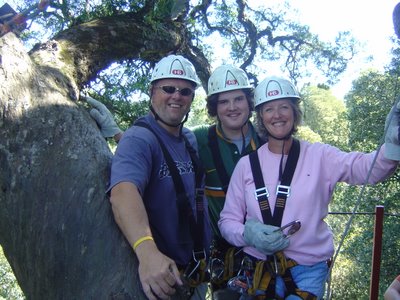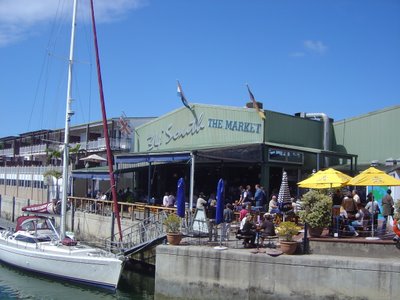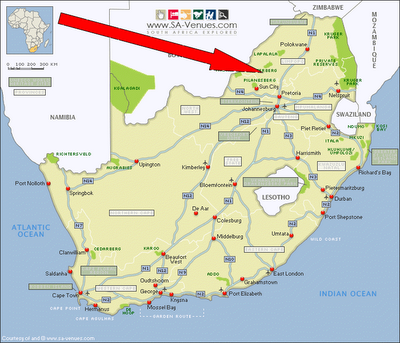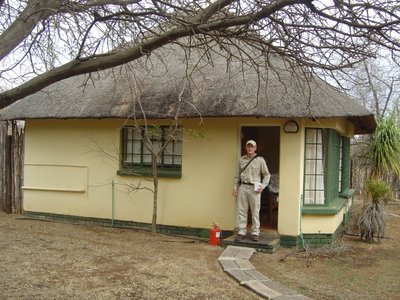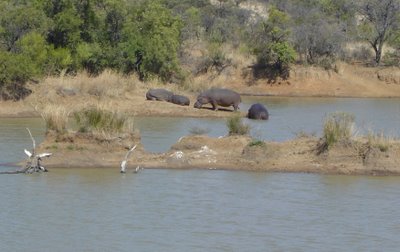At the end of March 2007, Carol and I took the dogs up into the Karoo for a few days, our main aim was to drive the Swartberg Pass, a twisty gravel road over the Swartberg mountains.
We stopped in a self catering cottage in Calitzdorp, there was a number of cottages grouped together around a courtyard. On the night we arrived we sat outside and had a braai with the owners and some of the other guests, who were there to visit the larges Afrikaans Arts Festival in the worls at nearby Outdshoorn.
The lady owner of the cottage made mustards and we bought a slection from her range, which included chilli, garlic, chardonnay with sun dried tomatoes.
On the morning of day three Noah was sitting out on the veradah with me, I left him for a second, during which the gardener suddenly appeared and startled Noah. Noah went for him and as looked out the cottage door, I just caught sight of Noah in mid air about to land on the back of a running away gardener. Fortunately the gardener was not hurt just shaken, Noah came straight back when I shouted at him.
It was very very hot during this visit, in the low 40c and it was all to much for Solomon who was struggling with the heat, the truck and just about everything. So we cut our visit short by a day and took a slow drive home.
But this is definately an area we will visit again as there are many gravel roads that just wonder all over the Karoo.



The 27 km Swartberg Pass is considered one of the most impressive mountain passes in the world: an untarred road that winds to the summit 1583 meters above sea level in steep zigzags and sudden switchbacks with breathtaking views at every turn. The road is supported in places by hand-packed stone walls, a trademark of Thomas Charles Bain, the brilliant road engineer of the 19th Century. Along the way there are relics of old prisons, tollhouses, and Way stations that bear historic testimony to past adventures. Often covered with snow in winter, the mountain's microclimate supports fynbos and a rich bird life, in contrast with the arid-zone flora and fauna outside its cool shady kloofs. The Swartberg Pass was declared a National Monument in its Centenary year, 1988. Those who have crossed the pass will never forget it.


On the far side of the pass we found some spectacular rock formations and an attractive mountain stream.
Having successfully crossed the Swartberg Pass we drove into the very nice Karoo town of Prince Albert and had lunch. Prince Albert is crammed with really nice cafe's, coffee shops and restuarants, so its a good place to visit and well, eat.
After lunch we drove back to our accommodation in Calitzdorp, via Outdshoorn and the Meiringspoort pass.
Meiringspoort is a deep cleft through the seemingly impenetrable Swartberg Mountain range. This natural passage forms a convenient link between the Great and Little Karoo. Soaring cliff walls with spectacular rock formations line the 25 km tarred road, which winds along the floor of the gorge, crossing the Groot River 25 times. Entry to the Poort is via Klaarstroom, 55 kms east of Prince Albert, en route to Oudtshoorn and the coast. Hardy plants, including indigenous pelargoniums, cling to the precarious rock faces while birds, baboons and smaller fauna abound in the protected kloofs & crevices. Among the most scenic spots is the waterfall tumbling into a dark pool that, according to legend, is bottomless. In Meiringspoort one feels insignificant against the overwhelming grandeur of the surroundings. Driving through this Poort with its winding road, the traveller is enchanted by the scenery with a kaleidoscope of every changing colour. The richness of the vegetation along the river will intrigue plant lovers and birdwatchers will be amazed at the bird life. Meiringspoort was originally opened to traffic on the 3rd March 1858.
Calitzdorp is the Port capital of South Africa and you can visit many of the vineyards who produce this fortified red wine.
This fertile valley was originally a lake. The soil is mainly alluvial and agricultural crops are grown 1 km on either side of the rivers (Nel’s and Gamka – lion in khoi).
Early writings prove that the khoi called Kannaland ‘the valley with no grass’. Evidence of early San and Khoi peoples are evident in numerous rock paintings found In the surrounding mountains.
In 1821, land was granted to JJ and MC Calitz who named it Buffelsvlei. This name was derived from the local vegetation and animals found here.
In 1853, the Calitz’s donated land for a church and school to be built, as Oudtshoorn proved to be too far to travel for their monthly ‘Nagmaal”.
In 1910, the population was 4000 and a larger church and school were needed. Both buildings were completed in 1912 The church has a neo-Byzantine style with a Marseilles roof. It is a good example of the sandstone architecture of the ostrich-era In the little Karoo. It was declared a national monument in 1991.
Also in 1912 , building commenced on the old Standard Bank building , presently housing the museum , and the Calitzdorp dam. This dam wall was the first of many to be built in South Africa ,using cement.
Subsequent drought, the great flu epidemic, and the collapse of the ostrich feather industry, played havoc amongst the community.
New hope however, came to Calitzdorp in the form of a Railway line (in 1924) and Electrification (in 1937 ), as well as the construction of the first cement road between Calitzdorp and Oudtshoorn ( also a first for South Africa ). The new R62 was built in 1978.
Today , this Klein Karoo thriving community is known as the "Port Wine Capital of South Africa" , and the "Fruit Basket of Kannaland" .
Port-grape varieties prefer a hot, dry, climate such as that of Calitzdorp. There are quite a lot of similarities between the climate of Calitzdorp and the Douro valley in Portugal. The poor, well-drained soils of Calitzdorp, where vines struggle to ripen, are very suitable for port - wine production. These port-wines are produced from internationally recognized varieties such as Tinta Barocca and Touriga Nacional. A blend of these varieties enhances the aroma-intensity, depth and complexity of these port-wines. Last, but by no means least the dedication of the port-makers is pivotal in the production of these prizewinning port-wines, made in the classic tradition of a high alcohol and relatively low sugar content.















